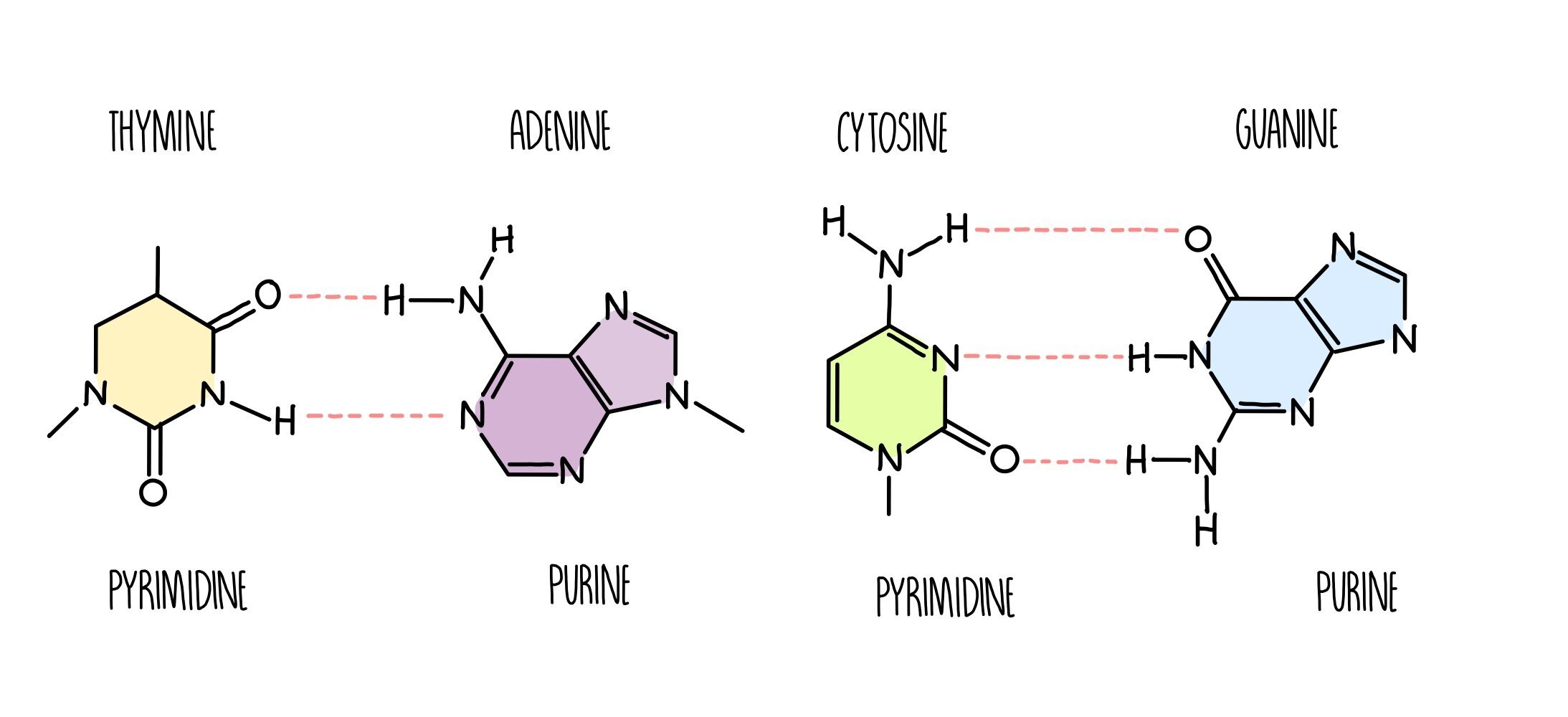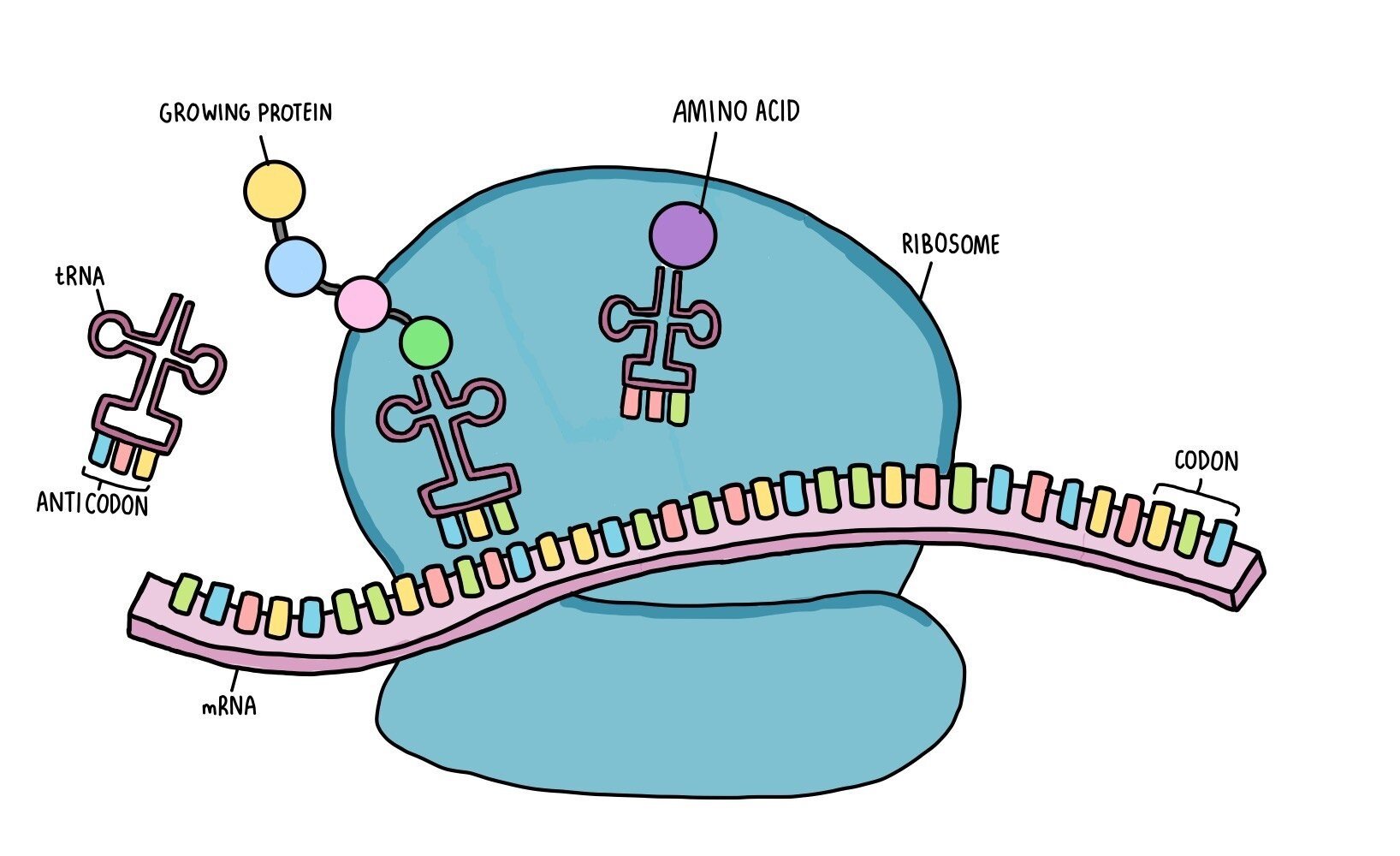DNA and Genetics
Nucleic acid structure
Nucleic acids are long chains (polymers) of lots of nucleotide monomers joined together by phosphodiester bonds. Each nucleotide is made up of three components:
Pentose sugar (either deoxyribose or ribose),
Nitrogenous base (guanine, cytosine, adenine, thymine or uracil)
Phosphate
DNA consists of two nucleic acid strands bonded together by complementary base pairing, the strands twisted around each other to form a double helix. The two strands have the same sequence running in opposite directions so we say they are anti-parallel. The bonding between bases is predictable, since guanine always pairs with cytosine with three hydrogen bonds holding them together.Adenine always bonds with thymine (in DNA) or uracil (in RNA) with two hydrogen bonds between them. Adenine and guanine are purines, which mean they have a large double ring structure. Cytosine and thymine are pyrimidines, which are smaller as they are composed of a single ring. Notice that a purine always base pairs with a pyrimidine - this happens because it’s the only way DNA can keep a regular shape and not become too bulky or narrow.
There are some important differences between a molecule of DNA and RNA:
They contain different sugars - the pentose sugar in DNA is deoxyribose and in RNA is ribose. The difference is that deoxyribose has one less oxygen atom.
RNA contains uracil instead of thymine
DNA is double-stranded whereas RNA is single-stranded
DNA has hydrogen bonds between the two complementary strand
During DNA and RNA synthesis, nucleotides are connected through the formation of phosphodiester bonds (a type of covalent bond) between the phosphate group on one nucleotide and the pentose sugar of the next nucleotide. It is a condensation reaction which means that water is formed during the reaction and it is catalysed by an enzyme called DNA polymerase or RNA polymerase depending on whether a DNA or RNA strand is being synthesised. Breaking phosphodiester bonds requires the addition of a water molecule, so it is a hydrolysis reaction.
Types of RNA
Messenger RNA (mRNA)
o Produces during transcription – RNA polymerase uses DNA as a template to provide mRNA strand
o Carries the genetic code from the nucleus to the cytoplasm – provides the instructions for making a protein on the ribosome in translation
o Made up of triplets of bases called codons
Transfer RNA (tRNA)
o Carries amino acids to the ribosome during translation
o Contains an amino acid binding site at one end and an anticodon at the opposite end
o Anticodons bind to complementary codons on mRNA to convert the mRNA sequence into a protein’s primary sequence
Protein synthesis
DNA is too large to leave the nucleus (and too precious to be damaged), so it is first converted into messenger RNA in transcription, which moves into the cytoplasm and binds to a ribosome. Here, it is used to synthesise a protein in the process of translation.
Transcription
For a gene to produce a protein, the DNA within the gene must first be copied into RNA in a process called transcription. During transcription, RNA polymerase binds to the beginning of a gene in an area known as the promoter region. The promoter region is a regulatory region which does not code for amino acids but facilitates the process of transcription by helping RNA polymerase bind to the gene. RNA polymerase separates the DNA strands, producing a single DNA template for transcription. As RNA polymerase moves along one of the DNA strands (the template strand), it adds complementary nucleotides and connects them through the formation of phosphodiester bonds. The other strand is referred to as the coding strand and will have an identical sequence to the newly synthesised RNA, except for the presence of thymine instead of uracil. Eventually RNA polymerase will reach a codon which does not code for an amino acid but tells the enzyme to stop transcribing (these are called stop codons). A molecule of messenger RNA (mRNA) has been formed which will leave the nucleus and enter the cytoplasm.
Translation
Once in the cytoplasm, the messenger RNA finds its way to structures called ribosomes.
The ribosome attaches itself to the RNA and slides along it (this is known as translocation). The ribosome ‘reads’ the mRNA in a series of three bases (such as AUG, CCA, GCU) called codons. Each codon corresponds to a particular amino acid.
As the ribosome reads the codons, a transfer RNA (tRNA) molecule which has a complementary anticodon carries an amino acid to the ribosome. Once the ribosome has read through the length of the mRNA, a series of different amino acids will have been dropped off by several tRNA molecules.
The ribosome catalyses peptide bond formation (condensation reaction) between the amino acids to form a polypeptide.
tRNA molecules have an usual clover-shaped structure, formed by a single RNA strand folded over on itself through hydrogen bonding. At one end of the molecule, there is an amino-acid binding site and at the other there is an anticodon, which contains a complementary base sequence to the mRNA codon.
The Nature of the Genetic Code
The genetic code can be described in a number of ways - it is a triplet code, non-overlapping, degenerate and universal.
Triplet code: three nucleotide bases make up a codon, which code for a particular amino acid.
Non-overlapping code: the codons do not overlap. Once the ribosome has ‘read’ one codon and the appropriate amino acid has been recruited, the ribosome moves onto a new codon.
Degenerate code: different codons can code for the same amino acid. For example, the codons CUU and CUC both code for the amino acid leucine. This means that some mutations will have no effect on the organism since the same protein will still be produced.
Universal code: all organisms use the same genetic code. Bacteria, bonobos and bananas all contain DNA made up of the four nitrogenous bases that are found in humans.



